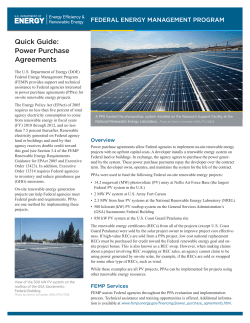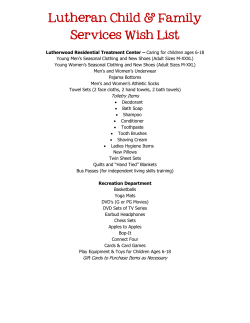
How to Buy an Energy-Efficient Commercial Unitary Air Conditioner
How to Buy an Energy-Efficient Commercial Unitary Air Conditioner Why Agencies Should Buy Efficient Products ■ Executive Order 13123 and FAR part 23 direct agencies to purchase products in the upper 25% of energy efficiency, including all models that qualify for the EPA/DOE ENERGY STAR® product labeling program. ■ Agencies that use these guidelines to buy efficient products can realize substantial operating cost savings and help prevent pollution. ■ As the world's largest consumer, the federal government can help "pull" the entire U.S. market towards greater energy efficiency, while saving taxpayer dollars. Energy Efficiency and Renewable Energy Federal Energy Management Program Federal Supply Source: • Defense Logistics Agency (DLA) Phone: (800) 352-2852 www.dscp.dla.mil/gi/general/eUnitary/ Unitary.htm For More Information: • DOE’s Federal Energy Management Program (FEMP) Help Desk and World Wide Web site have up-to-date information on energyefficient federal procurement, including the latest versions of these recommendations. Phone: (800) 363-3732 www.eren.doe.gov/femp/procurement • Environmental Protection Agency maintains a list of ENERGY STAR® compliant models of commercial unitary air conditioners. Phone: (888) 782-7937 www.energystar.gov/products • Consortium for Energy Efficiency (CEE) has utility programs promoting energy-efficient commercial air conditioners and publishes guidelines for good installation practices. Phone: (617) 589-3949 www.cee1.org • American Council for an Energy-Efficient Economy (ACEEE) publishes the Guide to Energy-Efficient Commercial Equipment. Phone: (202) 429-0063 aceee.org • American Society of Heating, Refrigerating and Air Conditioning Engineers (ASHRAE) publishes the Cooling and Heating Load Calculation Manual. Phone: (800) 527-4723 www.ashrae.org • Pacific Northwest National Laboratory (PNNL) supports FEMP’s campaign on the procurement of highly efficient unitary air conditioners. Phone: (503) 417-7558 www.pnl.gov/uac • Lawrence Berkeley National Laboratory provided supporting analysis for this recommendation. Phone: (202) 646-7950 CE-3 Definitions Efficiency Recommendation Product Typea and Size Recommended Best Available < 65 MBtu/h (3 phase) 12.0 SEER or moreb 14.5 SEER 65 – 135 MBtu/h 11.0 EER or more 11.4 IPLV or more 11.8 EER 13.0 IPLV > 135 – 240 MBtu/h 10.8 EER or more 11.2 IPLV or more 11.5 EER 13.3 IPLV a) Only air-cooled single package and split system units used in commercial buildings are covered. Water source units are not covered by ENERGY STAR; but look for efficiency ratings that meet or exceed these levels for air source units. EER, or Energy Efficiency Ratio, is the cooling capacity (in Btu/ hour) of the unit divided by its electrical input (in watts) at the Air Conditioning and Refrigeration Institute’s (ARI) standard peak rating condition of 95oF. SEER (Seasonal Energy Efficiency Ratio) and IPLV (Integrated Part-Load Value) are similar to EER but weigh performance at different (peak and off peak) conditions during the cooling season. b) Where operating conditions are often close to rated conditions or in regions where there are high demand costs, look for units with the highest EER ratings that also meet or exceed this SEER. For contractor-supplied equipment, specify an ENERGY STAR labeled model or one that meets or exceeds these recommended levels. In early 2002, the Defense Logistics Agency (DLA) expects to offer highly efficient commercial unitary air conditioners whose efficiencies meet or exceed these recommended levels (see “Federal Supply Source”). DLA will select models through a competitive procurement based on lowest life-cycle cost. How to Select Energy-Efficient Commercial Air Conditioners Over-sizing of air conditioners, besides raising purchase cost, will increase energy use, reduce humidity removal, and shorten product life, all due to excessive on-off cycling (“short-cycling”). The required air conditioner capacity should be determined based on the referenced ASHRAE calculation procedure (see “For More Information”). Sizing Commercial unitary air conditioners can usually be purchased with several options for heating, including a gas or oil furnace, hot water or steam coils, or electric resistance heating. Heat pump models will use less Heating Options PAGE 1 NOVEMBER 2001 energy than electric resistance heating (see “How to Buy an Energy-Efficient Commercial Heat Pump”). Many factors (not reflected in the efficiency ratings) can affect the energy performance of a commercial unitary air conditioner. Water source models, which use cooling towers, are generally more efficient than air source models, but have higher first costs and maintenance requirements. Economizers provide “free” cooling by using controllable dampers that bring outside air to cool the space when the outdoor temperature or enthalpy are below the building’s return air. When properly controlled and maintained, economizers can decrease energy consumption substantially. Two-speed fans allow for decreased energy use in ventilation-only mode, when neither heating nor cooling is needed. Economizers, two-speed fans and other features have impressive energy-saving capability, but usually requires operation by an appropriate and well calibrated control system. Technology Options Proper installation and maintenance of commercial unitary air conditioners are essential for effective and efficient operation. ACEEE’s “Guide to Energy-Efficient Commercial Equipment”, along with other publications from CEE and PNNL that provide tips on installation and maintenance concerns (see “For More Information”). Duct losses are a major source of energy waste and comfort problems; make sure ducts are well-sealed. Installation and Maintenance Many of today’s commercial unitary air conditioners use HCFC refrigerants and other refrigerants with a low Ozone Depletion Factor (ODF). When retiring an air conditioner that contains CFCs or HCFCs, the Clean Air Act requires that the refrigerant be recovered on-site by a certified technician. For information, contact EPA’s hotline at (800) 296-1996. Environmental Tips Assumptions Air Conditioner Cost-Effectiveness Example (120 MBtu/h – 10 tons) Base Modela Recommendedb Best Available 8.9 / 9.2 11.0 / 11.4 11.8 / 13.0 Annual Energy Use 19,600 kWh 15,800 kWh 13,800 kWh Annual Energy Cost $1,170 $950 $830 Lifetime Energy Cost $11,700 $9,500 $8,300 — $2,200 $3,400 Performance EER / IPLV Lifetime Energy Cost Savings a) The integrated part-load value (IPLV) corresponds to an average model meeting the minimum national standard EER of 8.9. b) For illustration only, there may not be an actual model available that just meets both EER and IPLV efficiency criteria. Using the Cost-Effectiveness Table In the example shown above, a commercial unitary air conditioner with an IPLV of 11.0 is cost-effective if its purchase price is no more than $2,200 above the price of the Base Model. The Best Available model, with an IPLV of 13.0, is cost-effective if its price is no more than $3,400 above the price of the Base Model. The cost effectiveness example assumes annual energy use in this example is based on the standard DOE test procedure for a model with 1,500 equivalent fullload hours per year. The assumed electricity price is 6¢/kWh (including demand charges Definition Lifetime Energy Cost is the sum of the discounted (present) value of annual energy costs based on average usage and an assumed air conditioner life of 15 years. Future electricity price trends and a discount rate of 3.3% are based on federal guidelines (effective from April, 2001 to March, 2002). What if my Electricity Price, Hours of Operation, or Capacity is different? Metric Conversions FEMP provides a web-based “energy cost calculator” screening tool that simplifies energy cost comparisons between different commercial unitary air conditioners. This cost calculator allow you to adjust the capacity, hours of operation, and electricity cost for your installation. To use the calculator, go to www.eren.doe.gov/femp/procurement/ calc_uac.shtml. 1 MBtu/h = 1,000 Btu/h = 293 Watts °F = (1.8 * °C) + 32 PNNL has also developed a web based screening tool for FEMP’s promotional campaign for the procurement of highly efficient commercial unitary air conditioners. This tool is based on a weather bin-temperature calculation method. To use the PNNL calculator, go to www.pnl.gov/uac. CE-3 PAGE 2 NOVEMBER 2001
© Copyright 2025



















![[Type text] Michael R. Vaughn, P.E. TO:](http://cdn1.abcdocz.com/store/data/000253465_1-a46419cfebb96f47e293e6d7991cf1b1-250x500.png)

